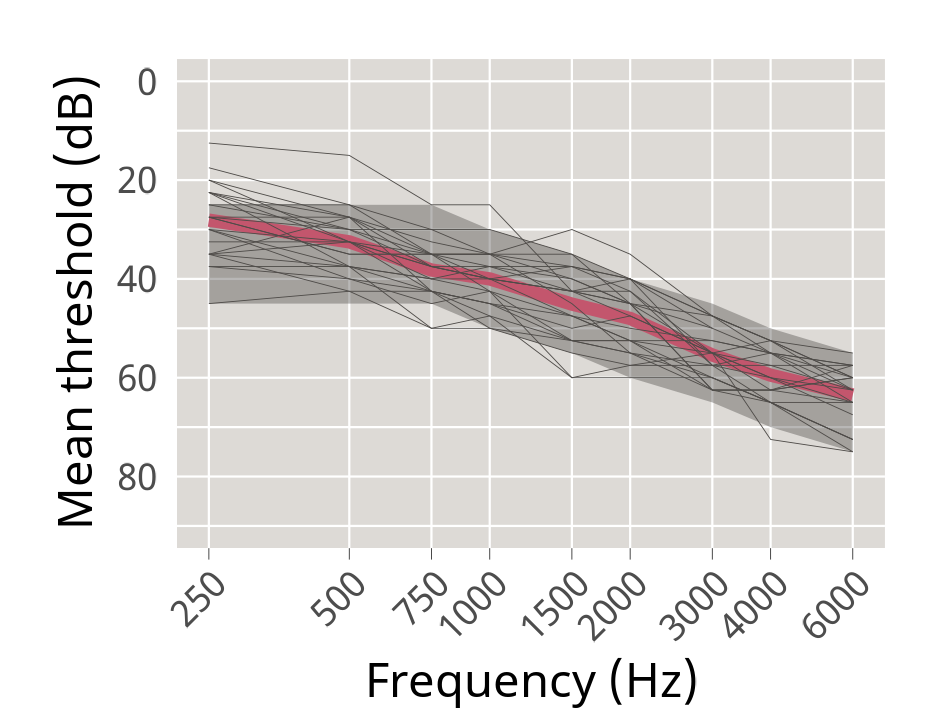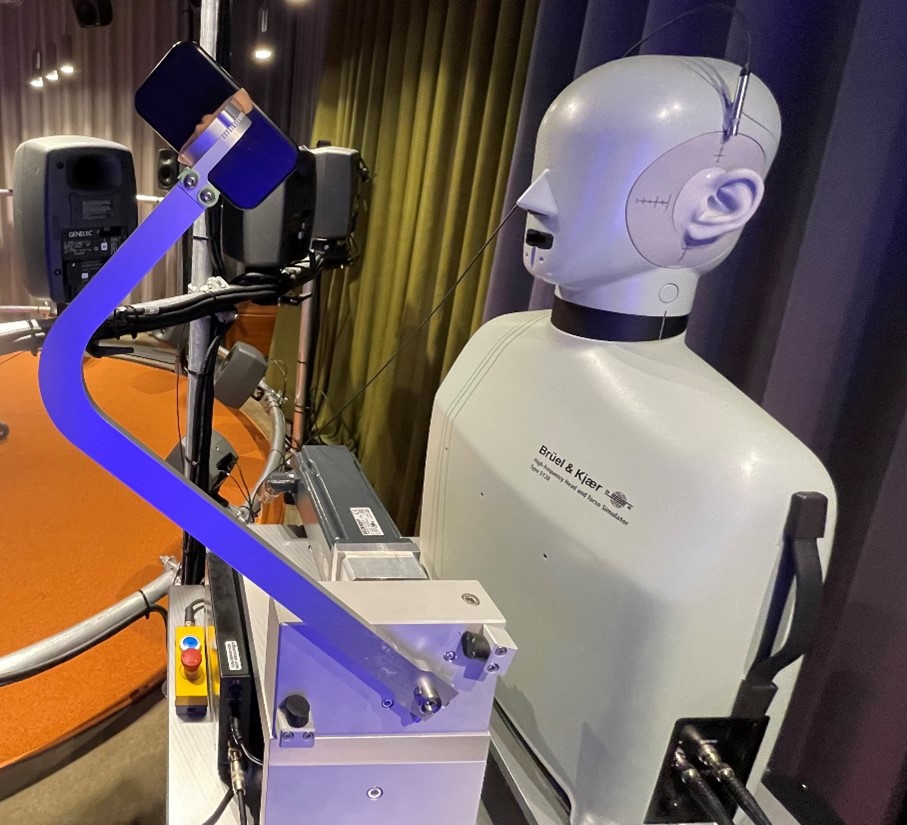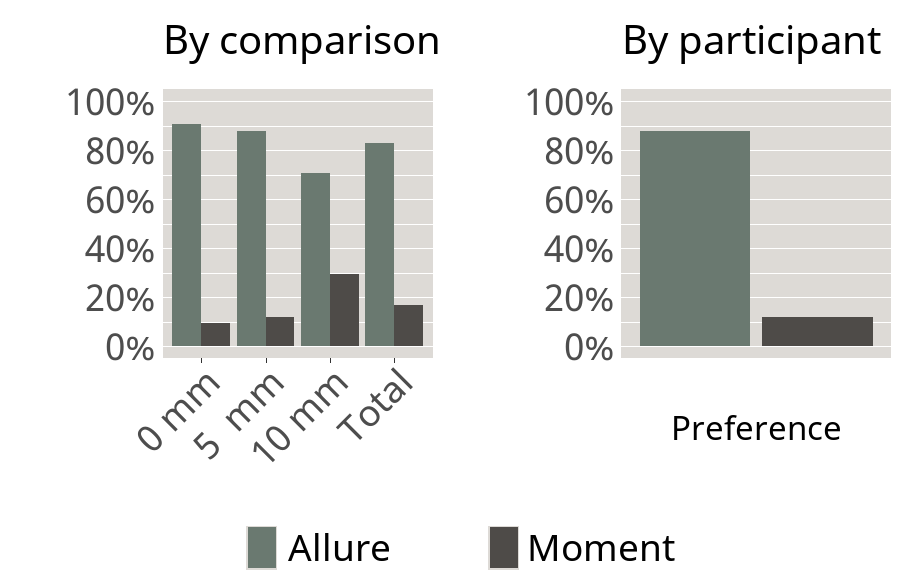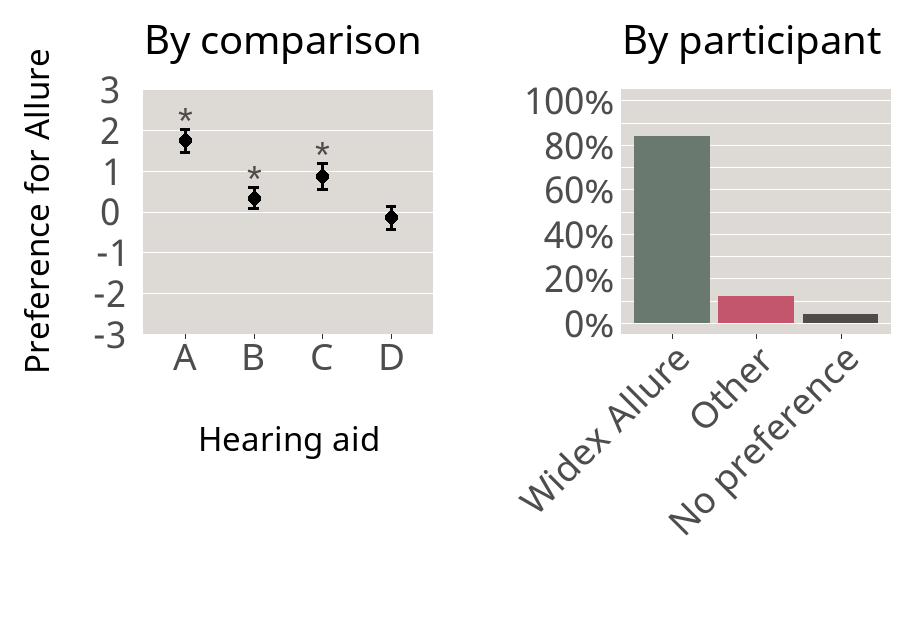Learning Outcomes
After this course learners will be able to:
- Describe what frequency shifting is and how it is used in current hearing aid processing.
- Discuss the trade-off between feedback management and sound quality in hearing aids.
- Explain how the Widex Allure Dynamic Feedback Controller balances feedback management and sound quality and how this impacts hearing aid listeners’ experience.
Introduction
Feedback cancelling (FBC) is a central problem for hearing devices in two ways: The first and most obvious problem is that users want to avoid audible feedback in their hearing aids, making it a key concern for hearing aid manufacturers to manage feedback. The second problem arises as a consequence of attempts to solve the first problem, in that common feedback-cancelling strategies may result in artifacts, and thus negatively impact the sound quality of hearing aids, with all the harmful consequences that reduced access to natural sound may have for users
In order to understand this balance of feedback management, consider the cause of audible feedback. Feedback arises when the output of the receiver feeds back in a loop to the microphone. This turns into audible feedback oscillations – whistling or buzzing – when the input grows stronger as it moves more times through the feedback loop, so-called positive loop gains. These arise when the feedback path changes; the most typical case is when a physical entity – like a telephone, the brim of a hat, or a person the hearing aid user is hugging – reflects the sound near the ear. The feedback path may also change when the hearing aid moves, or when the ear canal changes due to talking or chewing. Audible feedback typically occurs in a frequency region from 1.5 to 6 kHz.
One way of managing feedback is to apply gain reduction, when the hearing aids estimate that audible feedback may be happening. This of course comes at the cost of reduced gain, potentially resulting in reduced audibility for the hearing aid user and in noticeable fluctuations of the sound, unless the return to the original gain is done very slowly. Another common strategy for managing feedback relies on frequency shifting, where the amplified signal is shifted by a small frequency so that the original and the amplified signals become decorrelated, allowing the feedback management system to more efficiently distinguish feedback sounds from environmental sounds, to adapt its model of the feedback path, and to cancel the feedback more efficiently.
The frequencies with which the signal is shifted are typically so small that even a trained musician will hardly be able to detect the shift in the relevant frequency regions above 1 kHz. In other words, the slight shift of the amplified signal’s frequency has no practical effect in itself. However, in actual fittings where venting is the norm, the mixing of the direct sound with the amplified signal becomes a real problem: When the non-shifted signal coming through venting and leakage mixes with the amplified signal that has been frequency shifted, artifacts may arise, with originally unmodulated tones warbling. Such artifacts become more pronounced as the frequency of the signal becomes lower and the amplitude of the direct and amplified signals becomes more equal. In this way, frequency shifting, though an efficient contributor to feedback management, can be a significant sound quality detractor.
The new Widex Allure™ hearing aid platform overcomes these challenges with its Dynamic Feedback Controller by applying frequency shifting in a flexible way. This allows the system to reduce the risk of audible feedback and to provide headroom for fitting with more open ear-tips than on previous platforms, while at the same time retaining the signature Widex sound quality. In other words, the Dynamic Feedback Controller is all about improving feedback management, while not compromising the Widex sound.
The key differentiator is that while many other hearing aids apply frequency shifting constantly across most or all frequencies, the Allure Dynamic Feedback Controller is adaptive in several ways:
- The size of the frequency shift varies between 11 and 22 Hz. The bigger frequency shift of 22 Hz is used if the hearing aid is close to the stability limit, i.e., if there is a relatively high risk of audible feedback.
- The speed with which the Dynamic Feedback Controller adapts is variable, with faster changes when the hearing aid is close to the stability limit and slower changes when it is far from the stability limit.
- The cut-off frequency between the frequency region where the frequency shift is applied and the region where it is not applied is adapted in a way that is customized to the individual hearing aid user and to the hearing aids’ model for the estimated feedback path, the so-called modelled loop gains, in the situation. This is crucial because the lower the cut-off frequency, the more audible the frequency shift becomes.
The cut-off for frequency shifting moves between 850 Hz and 2.7 kHz (see Figure 1): Frequency shifting never happens below 850 Hz, a region where audible feedback is rare and frequency shifting more likely to be audible. Conversely, it always happens above 2.7 kHz, where, given the logarithmic nature of hearing, the frequency shifting will not generally be audible. In the region between 850 Hz and 2.7 kHz, the frequency shift is applied flexibly, depending on two parameters: the amount of direct sound coming through the vent (the vent rule), and the margin between the loop gain modelled by the hearing aid and the critical region for feedback (the margin rule). Together, these parameters affect the cut-off between frequency shifting and non-frequency shifting, i.e., where the frequency shift starts being applied in the adaptive region from 850 Hz to 2.7 kHz.

Figure 1. The frequencies at which the Dynamic Feedback Controller is activated, showing the adaptive frequency shift border in the Allure platform.
The vent rule is based on a comparison between the amplitude of the HA sound (which is frequency shifted) and the amplitude of the direct sound coming through the vent (which is not frequency shifted). Because the frequency shifting is most audible when two signals are of equal amplitude, the vent rule compensates by applying a higher cut-off frequency in this case, i.e., making frequency shifting start at a higher frequency. Conversely, when the direct sound is much softer than the hearing aid sound, the cut-off frequency may be lower without affecting the sound quality.
While the vent rule is based on the balance between direct and amplified sound, the margin rule considers the margin between the estimated feedback path at the given point in time and the critical region in which the hearing aid becomes unstable, known as the stability limit. When this margin grows narrow, the frequency shift is applied over a broader frequency region, with a cut-off closer to the 850 Hz shown in Figure 1, for more efficient feedback cancellation. When the margin is wider, the cut-off moves up, so that frequency shifting starts closer to 2.7 kHz to safeguard sound quality.
The timing with which the frequency shift region changes is important. On the Allure platform, when the border needs to be shifted down to accommodate an increased risk of feedback, this happens relatively quickly to help cancel the feedback. The audibility of this processing change will typically be masked by whatever sound change resulted in a changed feedback path. Upward shifts of the border are more gradual, in order to be unnoticeable to the hearing aid user.
In this way, the vent rule safeguards the Widex sound, while the margin rule reduces the risk of audible feedback. Importantly, this intelligent, adaptive way of applying frequency shifting is tailor-made to the individual: The vent rule is based on the individual hearing aid user’s venting, and the resulting balance between direct and amplified sound, relying on the unique Widex TruAcoustics algorithms which estimate venting for the individual hearing aid user based on the acoustic calibration. At the same time, the margin rule models the risk of feedback in the moment, adapting to the situation.
In addition to cancelling feedback more efficiently, the improved Dynamic Feedback Controller enables two other improvements on the Allure platform, namely more open eartip recommendations that are supported by the increased headroom, and the more flexible fitting range for Allure PureSound, a unique Widex hearing aid program that simultaneously optimizes sound quality and speech intelligibility for users with mild to moderate hearing loss (Weber & Branda, 2025).
To investigate the effects of these innovations on hearing aid users’ experiences, this article reports a rating study where the Allure Dynamic Feedback Controller was compared with the feedback-cancelling mechanism used on previous Widex platforms (Part 1), as well as other manufacturers’ current ways of applying frequency shifting (Part 2).
Participants
Twenty-five experienced hearing aid users (> 6 months of mostly full-time wear) participated in the study. Their mean age was 75 years (range 59 to 87). There were 14 females and 11 males. Participants had symmetrical sensorineural hearing losses in a range of +/- 10 dB around an N3 hearing loss
The study was conducted at Hörzentrum Oldenburg gGmbH in Germany, and all participants were native speakers of German.

Figure 2. Participants' average audiogram (across ears) is shown in red, with dark gray lines representing the mean thresholds of individual participants and the shaded area the inclusion criterion N3 +/- 10 dB.
Stimuli: Part 1
Both parts of the study relied on recordings, in order to allow direct comparisons between different feedback-cancelling mechanisms. In Part 1, the comparison was between the Dynamic Feedback Controller on the Widex Allure platform (using the ARRD1 receiver-in-canal form factor) and the feedback manager on the previous Widex Moment platform (using the MRR4D receiver-in-canal form factor). The hearing aids were fitted to a Head and Torso Simulator (HATS) manikin Type 5128 from Bruel & Kjær, with ear simulator Type 4620. The fittings were done for an N3 hearing loss, following the standard Widex fitting flow, including an acoustic calibration in Compass Cloud for Allure, and a feedback test in Compass GPS for Moment. Both devices were fitted with M-receivers and Sleeve Vented eartips. The fitting was done first for the Allure device, after which the gain of the Moment device was fine-tuned to match the gain of the Allure device for a 45 dB SPL speech signal. In this way, the recordings were gain matched and corresponded to the hearing losses of the participants as described above.
Separate recordings were done for each device fitted on the HATS, which was placed in an acoustically dampened room. While recording, the feedback path was systematically changed by moving a mechanical arm with a phone simulator at three different distances (0, 5 and 10 mm) from the pinna of the HATS (see Figure 3). The different distances from the ear constitute different changes to the feedback path, and in that way they mimic different real-life situations. While the mechanical arm moved, a speech signal in Danish was played back at a sound pressure level of 45 dB from a loudspeaker placed 80 cm in front of the HATS. The speech was a single sentence that was included only to give listeners an indication of the relative sound level of any audible feedback or other sound artifacts, so the Danish speech (used for pilot studies) could also be used with the German-speaking participants. The mechanical arm was constructed to move very silently, though it may have been just audible to some participants. After recording, the samples were post-processed to eliminate the ear canal resonance of the HATS, using a free-field-to-eardrum function, to avoid doubling the ear canal resonance when participants listened via over-the-ear headphones. All recorded samples were normalized to have the same RMS value, by identifying the recording with the highest RMS value and matching the remaining samples to that, to make sure that differences in feedback management strategies would not be confounded with any differences experienced in the loudness of the recordings.

Stimuli: Part 2
For part 2, the Widex Allure platform (using ARRD1, like above) was compared with the newest premium devices from four other major hearing aid manufacturers at the time of recording (May 2024). No changes to the feedback management systems of these manufacturers have been communicated since the recordings were made. The hearing aids were fitted using M-receivers and open couplings, and programmed to an N3 hearing loss
Recordings were made in an acoustically dampened room, with the hearing aids fitted to a HATS. Three different music samples were played back from a loudspeaker 120 cm in front of the HATS, and recorded using the HATS ear canal microphone. The samples were selected to represent different genres, with a jazz trumpet extract (15 seconds), a classical violin extract (15 seconds), and a rhythmic piano extract (16.1 seconds). The recordings were post-processed in a similar way to the recordings for Part 1 of the study.
Procedure
The recordings described above were played back to participants over headphones (Sennheiser HD600). In addition to the recordings being shaped to a hearing loss that was close to that of the participants, participants were allowed to adjust the volume to a comfortable listening level separately for each part of the experiment. After signing consent forms and adjusting the volume, the participants completed a short training on the pairwise comparison task, with the same stimuli as Part 1, before moving on to the main body of the experiment. The playback and ratings were done in a custom MATLAB software created to run variations of pairwise comparisons.
Part 1 consisted of simple forced-choice pairwise comparisons of recordings, with the two different hearing aids at the three different distances from the ear. Participants were asked to indicate which of the two recordings they preferred in terms of sound quality and audible feedback and other artifacts. The recordings ran in a continuous loop, and participants could change between them as many times as they liked, with a minimum of three changes necessary before they could indicate their preference. Each distance was compared three times for a total of nine comparisons in Part 1. For each of the three repetitions, the order of the three distances was randomized individually for each participant. The recordings were only four seconds long, and the difference was relatively clear to most participants, so this part of the experiment took only approximately four minutes.
In Part 2, recordings made with Widex Allure were compared to each of the recordings made with the hearing aids of the four other manufacturers. This was done separately for the three different music samples, resulting in a total of 12 comparisons per participant. In order to avoid a forced choice and the multiple repetitions of each comparison that this typically involves, this part of the experiment used a rating scale design. For each comparison, the participant listened to two samples, A and B, and evaluated the sound quality on a scale from +3 (“Strongly prefer A”) to -3 (“Strongly prefer B”), with a no-difference/no-preference option in the middle. Which hearing aid was assigned to A and B was randomized, as was the order of the hearing aids for a given sample. The music samples were blocked, so that all recordings of one music sample appeared together; these blocks appeared in a random order. The music ran continuously in a loop, with participants switching between A and B as many times as they liked, though with a minimum of three switches required. The experiment was self-paced, and the participants completed this part of the study in approximately 8 minutes.
Statistical Analysis
The statistical analysis of the results was done in R version 4.3.3
Results
The results of Part 1 can be considered from two perspectives: in terms of the proportion of comparisons in favor of Allure vs. Moment across participants, and in terms of each participant’s average preference. The first perspective is illustrated in the left panel of Figure 3, which shows a clear preference for Allure across all three distances from the ear, with a total of 83% of comparisons in favor of Allure, compared to 17% for Moment. This preference is highly significant on a Wilcoxon signed-rank test (W = 15, p < 0.0001), indicating a significantly improved experience of feedback on Allure compared with Moment.

Figure 4. The left panel shows the proportion of comparisons in favor of the two different hearing aids at the three different distances from the ear, and total across distances to the right. The right panel shows the proportion of participants with a preference for the two different systems.
The three distances from the ear are shown separately in the left panel of Figure 3, and the difference between the three distances was tested using a binomial mixed model, with binary preference as the dependent variable, distance as the explanatory factor, and participant as a random factor. This model showed a significant effect of distance from the ear (χ2 = 17.553, p = 0.0001), with the preference being stronger for the two closer distances than for the 10 mm distance. At the 10 mm distance, the difference may be smaller, because the feedback systems are less active, making the preference a little less systematic. However, the preference for Allure was significant at all distances from the ear (all p’s ≤ 0.01), indicating that Allure feedback management was preferred across different ways of changing the feedback path, and suggesting a robust effect across different real-life situations.
The second perspective on these results considers the preference by person, illustrated in the right panel of Figure 3. This splits the participants on whether they preferred Allure or Moment in the majority of the nine comparisons they each conducted, showing that 88% of participants preferred the Allure feedback-cancelling system in the majority of cases.
Having established with Part 1 that the feedback management on Allure is superior to the previous generation, Part 2 investigated the sound quality of the Allure hearing aids against four other manufacturers, in order to confirm that the careful design of the feedback management system outlined above does in fact preserve the high sound quality for which Widex is known. Across the four comparison hearing aids and across the three different sound samples tested, the preference for Widex Allure was highly significant (Wilcoxon signed-rank test W = 20.5, p < 0.0001). Figure 5 shows this preference split between the four different comparison hearing aids in the left panel. Mean ratings above 0 on the scale used in this part of the study indicate a preference for Allure; for three out of four comparison hearing aids (HAs A, B, C) this preference for Allure was significant, with no significant difference to the fourth comparison hearing aid (HA D).
Figure 5 illustrates the results of Part 2 analyzed by participant, showing the proportion of participants whose mean preference across HAs and samples was in favor of Allure, other hearing aids, or no preference. This shows that 84% of participants had an average preference in favor of Allure, compared to 12% in favor of other hearing aids, and 4% with an average rating of 0, indicating no preference.

Figure 5. The left panel shows the mean and standard error of the mean for the ratings of Allure against each of the other hearing aids in the study on the scale, from -3 (Much prefer the other HA) to +3 (Much prefer to Allure), with 0 indicating no preference. For HAs A, B and C, the mean ratings are significantly above 0, indicating a significant preference for Allure, while there is no significant preference regarding HA D. The right panel shows the proportion of participants whose mean preference across comparisons was in favor of Allure, other hearing aids, or neither (mean rating of 0).
Conclusion
The results of the two parts of the study show how Widex Allure addresses the dual problem of feedback management outlined at the beginning of this article: Part 1 shows that feedback management is much improved relative to the system on the previous platforms, while Part 2 shows that the sound quality of Widex Allure is superior to that of other leading manufacturers. Importantly, the superior feedback performance is experienced across different distances from the ear, which constitute different ways of changing the feedback path and in that way mimic diverse real-life situations. Similarly, the sound quality advantage is significant across samples, with Allure being preferred by 84% of participants.
Although driven by the adaptive function of the Dynamic Feedback Controller, the observed sound quality advantage is likely also related to other key elements of the Widex sound philosophy and design, such as the time-domain filter bank, which mirrors the processing in the cochlea
References
Balling, L. W., Mosgaard, L. D., & Helmink, D. (2022). Signal Processing and Sound Quality. Hearing Review, 29(2), 20–23.
Balling, L.W., Vormann, M. & Mansour, N. (2025). Widex Allure: A Better Speech-in-Noise Experience with Balanced Focus and Awareness. WidexPress 55.
Bates, D., Mächler, M., Bolker, B., & Walker, S. (2015). Fitting Linear Mixed-Effects Models Using lme4. Journal of Statistical Software, 67(1), 1–48.
Bisgaard, N., Vlaming, M. S. M. G., & Dahlquist, M. (2010). Standard Audiograms for the IEC 60118-15 Measurement Procedure. Trends in Amplification, 14(2), 113–120. https://doi.org/10.1177/1084713810379609
Buxton, R. T., Pearson, A. L., Allou, C., Fristrup, K., & Wittemyer, G. (2021). A synthesis of health benefits of natural sounds and their distribution in national parks. Proceedings of the Natural Academy of Sciences, 118(14), 1–6. https://doi.org/10.1073/pnas.2013097118/-/DCSupplemental
Kuznetsova, A., Brockhoff, P. B., & Christensen, R. H. B. (2017). lmerTest Package: Tests in Linear Mixed Effects Models. Journal of Statistical Software, 82(13), 1–26.
R Core Team. (2024). R: A Language and Environment for Statistical Computing. In R Foundation for Statistical Computing, Vienna, Austria.
Weber, J. & Branda, E. (2025). Improved speech intelligibility in noise with ultra-low delay. AudiologyOnline, Article 29261. Retrieved from https://www.audiologyonline.com
Citation
Balling, L., Vormann, M., Rose, S. & Hau, O. (2025). Widex Allure: balancing feedback management with sound quality. AudiologyOnline, Article 29262. Retrieved from https://www.audiologyonline.com





